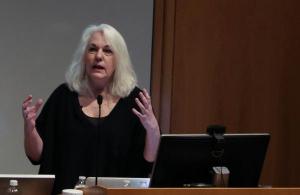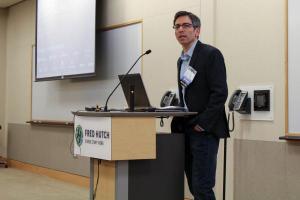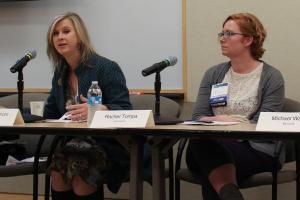By Emma Bueren
On April 28, the Fred Hutchinson Cancer Research Center (FHCRC), in Seattle, was bustling not only with its usual array of doctors and scientists, but also more than 170 visiting PIOs and science communicators attending an all-day conference hosted by the Northwest Science Writers Association (NSWA).
Goals of Compelling Science Storytelling: A Pacific Northwest Workshop for Science Communicators were to 1) expand the narrative tool kits of attending science communicators, whether PIO, reporter, or public relations specialist; 2) connect regional science communicators and institutions with one another; and 3) career development for new PIOs and science writers.Five thousand dollars in seed funding, courtesy of a NASW Idea Grant, launched the planning effort. Ten regional sponsors came on board contributing additional funding, scholarship underwriting, and the FHCRC venue. This level of support allowed the program to expand to two parallel tracks focused on PIO development and a variety of multimedia storytelling tools.
"It's a really interesting time to be situated in the media or as a science communicator," said conference co-chair Ellen Kuwana. "You have the traditional routes of how things were done — for example, press releases — and the burgeoning influence of social media."
A solution to such a diffuse media environment: the stories within the science.
Conference organizers include science writers and public information specialists from FHCRC, Group Health Research Institute, Institute for Health Metrics and Evaluation (IHME), Pacific Northwest National Laboratory, PATH, Public Health-Seattle and King County, Seattle Children's Research Institute, University of Washington, and Washington Global Health Alliance. Conference sessions included:- Running a narrative science/tech newsroom
- How universities promote research to spread science off campus
- Collaborating for high-impact social media campaigns
- Amplifying local work on the global stage
- Seeing social media in a crystal ball
- Beyond the press release: Best practices in pitching
- (En)lightening visuals
- What reporters want — and don't want — from PIOs
- How video can bring science to life
The opening panel described how the embedded newsrooms of FHCRC, Starbucks, and Microsoft use in-house news and feature writing to attract interest from both the general public and the media. "It's a challenge to figure out how to get that message out there for the greater good in a way it doesn't get lost in the noise," said panelist Linda Dahlstrom, who formerly ran the FHCRC newsroom before becoming the director of storytelling at Starbucks. "I think that's where telling authentic stories comes in."
Many of the multimedia-focused panels were live-streamed and remain available online: two morning sessions; three afternoon sessions plus keynote. A key take-away: Seek help and advice for advanced projects, even if it means using outside experts to create infographics or animations.
"You do have to pay for that work, but you save a lot of time and a lot of really painful meetings in which 10 non-experts try to decide how to do something," said Kuwana.Two mixers facilitated connections between science communication experts. In a post-conference survey, attendees listed networking as one of the most valuable aspects of the event.
"I'm relatively new to science writing, though I have several years of experience as a communications person, so I thought this was the perfect opportunity to learn about what was going on in this space regionally," said attendee Jill Reddish, the communications manager of the Center for Infectious Disease Research, Seattle.
The survey also revealed that more than 80 percent of respondents had not been to a science communication conference in the past three years. This may help explain why tickets sold out before the end of the early-bird pricing period.
In addition to Seattle-area science writers, there were attendees from Missouri, Utah, Colorado, California, Oregon, Idaho, and Vancouver, British Columbia.
"The demand and how quickly the conference filled up shows that people are hungry to make connections both professionally and personally," said Kuwana.
The conference concluded with keynote speaker Jacqui Banaszynski, a Pulitzer Prize winner for feature writing. Banaszynski's presentation, "Storytelling From the Campfire to the Cloud," focused on the power of both the narrative style and storytelling with emotion.
"My plea to you is to understand that our job is to communicate, and that means it's an act of compassion," Banaszynski said. "Every story we tell, every attempt we make to communicate, is designed to help make someone understand."
"We think of science as very cut-and-dried facts and concepts," said Kuwana. "But you have to affect [people] at an emotional level to get them to care about climate change, cleaning up toxins, or having drinkable water in Flint."
Conference co-chair Kuwana, Bill Heisel, and Jonathan Rabinovitz have put together a binder of meeting notes and planning records to assist others interested in holding a similar conference. This resource available by contacting NWSA.org or ellen.kuwana@gmail.com. A research institution in eastern Washington has already expressed interest in replicating some of the PIO-focused panels for its writers.
Emma Bueren is a scientist and freelance science writer.
(NASW members can read the rest of the Summer 2017 ScienceWriters by logging into the members area.) Free sample issue. How to join NASW.






